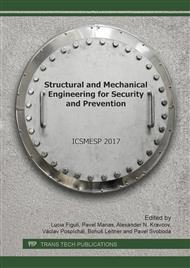[1]
Kalamar, R., Bedon, C., & Eliášová, M. (2017). Assessing the structural behaviour of square hollow glass columns subjected to combined compressive and impact loads via full-scale experiments. Engineering Structures, 143, 127-140.
DOI: 10.1016/j.engstruct.2017.04.016
Google Scholar
[2]
G. Balssa, G. Panofre, J. F. Hurstel, J. Bez, C. Capdevielle, and V. Sciortino. Explosion de l'usine AZF de Toulouse: description des lésions prises en charge au titre d'accident du travail par la Caisse primaire d'assurance maladie de la Haute-Garonne. 65(6): 463–469, (2004).
DOI: 10.1016/s1775-8785(04)93503-5
Google Scholar
[3]
Forquin, P. (2017). Brittle materials at high-loading rates: an open area of research. Phil. Trans. R. Soc. A 2017 375 20160436; DOI: 10. 1098/rsta. 2016. 0436.
DOI: 10.1098/rsta.2016.0436
Google Scholar
[4]
Amadio C, Bedon C. Buckling of laminated glass elements in compression. J. Struct. Eng. 2011; 137(8): 803–10.
DOI: 10.1061/(asce)st.1943-541x.0000328
Google Scholar
[5]
https: /erncip-project. jrc. ec. europa. eu/networks/tgs/buildings, consulted the 24th of April (2017).
Google Scholar
[6]
R. Müller and M. Wagner. Berechnung sprengwirkungshemmender Fenster- und Fassadenkonstruktionen. Bauingenieur, 81(11): 475–487, (2008).
Google Scholar
[7]
M. Timmel, S. Kolling, P. Osterrieder, and P. Du Bois. A finite element model for impact simulation with laminated glass. International Journal of Impact Engineering, 34: 1465–1478, (2007).
DOI: 10.1016/j.ijimpeng.2006.07.008
Google Scholar
[8]
D. Sun, F. Andrieux, A. Ockewitz, H. Klamser, and J. Hogenmüller. Modelling of the failure behaviour of windscreens and component tests. In 5th European LS-DYNA Users Conference, 25-26 May, (2005).
Google Scholar
[9]
X. Zhang, H. Hao, and G. Ma. Parametric study of laminated glass window response to blast loads. Engineering Structures, 56: 1707 – 1717, (2013).
DOI: 10.1016/j.engstruct.2013.08.007
Google Scholar
[10]
S. J. Bennison, A. Jagota, and C. A. Smith. Fracture of glass/poly(vinyl butyral) (butacite) laminates in biaxial flexure. Journal of the American Ceramic Society, 82(7): 1761–1770, (1999).
DOI: 10.1111/j.1151-2916.1999.tb01997.x
Google Scholar
[11]
H. D. Hidallana-Gamage, D. P. Thambiratnam, and N. J. Perera. Design guidance for blast-resistant glazing. Journal of Architectural Engineering, 21(3): 04015003, (2015).
DOI: 10.1061/(asce)ae.1943-5568.0000161
Google Scholar
[12]
M. Larcher, G. Solomos, F. Casadei, N. Gebbeken. Experimental and Numerical Investigations of Laminated Glass Subjected to Blast Loading. International Journal of Impact Engineering 39: 42-50, (2012).
DOI: 10.1016/j.ijimpeng.2011.09.006
Google Scholar
[12]
A. Burmeister. Moderne Fassaden - Explosionsschutz. In Glas im konstruktiven Ingenieurbau, Hochschule München, (2008).
Google Scholar
[13]
J. Pelfrene, J. Kuntsche, S. V. Dam, W. V. Paepegem, and J. Schneider. Critical assessment of the post-breakage performance of blast loaded laminated glazing: Experiments and simulations. International Journal of Impact Engineering, 88: 61 – 71, (2016).
DOI: 10.1016/j.ijimpeng.2015.09.008
Google Scholar
[14]
X. Zhang, H. Hao, and G. Ma. Parametric study of laminated glass window response to blast loads. Engineering Structures, 56: 1707 – 1717, (2013).
DOI: 10.1016/j.engstruct.2013.08.007
Google Scholar
[15]
Larcher, M., Arrigoni, M., Bedon, C., van Doormaal, J. C. A. M., Haberacker, C., Hüsken, G.,.. & Valsamos, G. (2016).
Google Scholar
[16]
A. van Doormaal, C. Haberacker, G. Hüsken, M. Larcher, A. Saarenheimo, G. Solomos, A. Stolz, L. Thamie, and C. Bedon. Numerical simulations for classification of blast loaded laminated glass: possibilities, limitations and recommendations - ERNCIP Thematic Group: Resistance of structures to explosion effects. Number JRC94928. Publications Office of the European Union, (2014).
DOI: 10.4028/www.scientific.net/kem.755.121
Google Scholar
[17]
John M. Biggs (1964), Introduction to Structural Dynamics, McGraw-Hill Companies.
Google Scholar
[18]
Unified Facilities Criteria UFC 3-240-02, 2008. Structures to Resist the Effects of Accidental Explosions, US Department of Defense, US Army Corps of Engineers, Naval facilities Engineering Command, Air Force Civil Engineer Support Agency – 5 December 2008 (replaces ARMY TM5-1300 of November 1990).
DOI: 10.21236/ada530875
Google Scholar
[19]
Locking P. The Trouble with TNT equivalence, 26th International Symposium of Ballistics, Miami, (2011).
Google Scholar
[20]
Dobratz, B. M., and P. C. Crawford. LLNL Handbook of Explosives, UCRL-52997, Lawrence Livermore National Laboratory., Change 2 (1985): 8-21.
Google Scholar
[21]
Cooper, Paul W., Stanley R. Kurowski, and Paul W. Cooper. Introduction to the Technology of Explosives. New York: VCH, (1996).
Google Scholar
[22]
Kingery, Charles N. Air blast parameters versus distance for hemispherical TNT surface bursts. No. BRL-1344. ARMY BALLISTIC RESEARCH LAB ABERDEEN PROVING GROUND MD, (1966).
Google Scholar
[23]
Kinney, Gilbert Ford, and Kenneth Judson Graham. Explosive shocks in air., Berlin and New York, Springer-Verlag, (1985).
Google Scholar
[24]
Karlos V; Solomos G; Larcher M. Analysis of the blast wave decay coefficient using the Kingery-Bulmash data. International Journal of Protective Strutures, 7 (3): 409-429, (2016).
DOI: 10.1177/2041419616659572
Google Scholar


